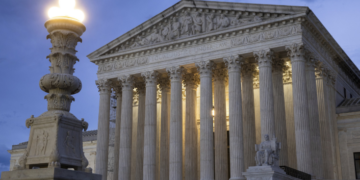Feb 9, 2025 Story by: Editor
Hamtramck, Mich. (AP) — Leslie Knox was just a child in the 1960s when her city near Detroit faced allegations of deliberately destroying Black neighborhoods to drive out residents.
Now, decades later, the retired nurse has returned to Hamtramck, settling into a newly built two-story home on Gallagher Street. As she decides how to furnish it, she watches TV from a fold-up chair, relieved that she only has to cover property taxes and insurance—without a mortgage.
Knox is among the last beneficiaries of a landmark legal settlement that obligated the small city to construct 200 homes for victims of racial discrimination or their families. The lawsuit, originally filed in 1968, turned into one of the longest-running civil rights housing cases in U.S. history.
Now, it has finally reached its conclusion.
“I feel like I’ve been given this house by divine intervention because no man in their right mind would just hand the keys to houses,” said Knox, 70, who placed two Black angel figurines on a kitchen window. “I believe God put me here.”
A ‘dark chapter’ comes to a close
Hamtramck’s mayor, Amer Ghalib, a Yemeni native elected in 2021, acknowledged the city’s troubling past but emphasized that those days are over.
“This is not going to happen again,” Ghalib said. “We are a very diverse community.”
‘We just want you gone’
Hamtramck attracted waves of Eastern European immigrants, particularly Polish workers, in the early 1900s. The city’s deep Polish roots even drew visits from Catholic Cardinal Karol Wojtyla in 1969 and again in 1987—by then, as Pope John Paul II. A statue of him still towers over a public plaza.
However, while white residents felt welcomed, many Black residents experienced discrimination. In 1971, U.S. District Judge Damon Keith ruled that Hamtramck had intentionally targeted Black neighborhoods for demolition.
“It was an attempt to eliminate a Black population,” said Michael Barnhart, a lawyer representing the victims. “It wasn’t, ‘We want this land for something and therefore you’re in the way.’ ‘We just want you gone’—that was the motivation, to get rid of people.”
For years, the city fought legal battles before finally agreeing in 1981 to build housing as a remedy. The settlement included apartments for seniors and 200 scattered-site homes for families, prioritizing those with specific income levels and a connection to the class-action lawsuit.
A decades-long wait
Why did it take until 2024—more than 40 years—to fulfill this promise?
“The city didn’t have the money,” explained James Allen, an attorney who represented Hamtramck in the final stages of the case.
Hamtramck faced severe financial struggles, leading the state to take over its finances twice, beginning in 2000. Even in 2010, with dozens of homes still unbuilt, a ribbon-cutting ceremony attended by Michigan Gov. Jennifer Granholm on Martin Luther King Jr. Day marked slow progress.
“Most if not all of the construction funding was through federal and state grants,” Allen said. “If the city had been left to its own devices, they never would have been able to do it. They just didn’t have the resources.”
The final three homes, including Knox’s, cost roughly $1 million to construct.
A city transformed
Hamtramck’s fortunes have long been tied to the auto industry. At its peak in the 1950s, more than 30,000 people worked at the Chrysler Dodge Main factory. By 1980, when the plant shut down, the workforce had dwindled, and the population declined sharply. As Polish Americans left, new immigrants from Yemen, Bangladesh, Bosnia, and other countries arrived.
Today, Hamtramck remains a dense, two-square-mile city filled with two-story flats and narrow streets. A General Motors plant now manufactures electric vehicles in a facility straddling Hamtramck and Detroit. The city’s population has rebounded to 27,000—20% higher than in 2010—though still far from its early 20th-century peak.
According to the U.S. Census Bureau, Hamtramck’s median household income in 2023 was $40,000, compared to the state’s $71,000.
A striking cultural shift
The city’s leadership has also changed. The mayor and city council members are now all Muslim. Amid the Israel-Hamas war, a portion of Holbrook Street was renamed Palestine Avenue. Amar Pizza, which incorporates Bangladeshi flavors, gained national recognition when The New York Times named it one of America’s best pizzerias last year.
St. Ladislaus Catholic Church—once a landmark visited by a future pope—has closed and is up for sale. Meanwhile, the Muslim call to prayer echoes through the city.
“Sometimes they’ll wake me up at 6 a.m. because it’s on a loudspeaker,” Knox said. “I’m Christian so when they pray in Yemeni I pray in my spiritual language.”
Knox doesn’t recall exactly why her Black family left Hamtramck when she was a child. She applied for the lawsuit settlement and was among the last three chosen, relocating from nearby Detroit in November.
‘I was put here for a reason’
“I do reflect about the history,” Knox said. “I believe I was put here for a reason. I can’t explain it. … I’m already 70 and just startin’ all over again.”
Hamtramck has chosen to acknowledge rather than ignore its history. A park in the city honors Sarah Sims Garrett, the lead plaintiff in the lawsuit, with a monument detailing the long fight against discrimination.
Her son, Dwydell Garrett, 59, also received a home through the settlement. His mother’s legacy motivated him to return.
“It’s a very special honor to have someone raise me as not being bitter for things that went on,” Garrett said. “I can’t hold a grudge.” Source: AP News

















